To be able to support their condition, which they denied at their very heart, the slaves would resist, a resistance that took on two forms. The first was violent: escaping, flight by sea and revolt. The other was non violent: singing, refusal to conceive children, dancing, puns and humour.
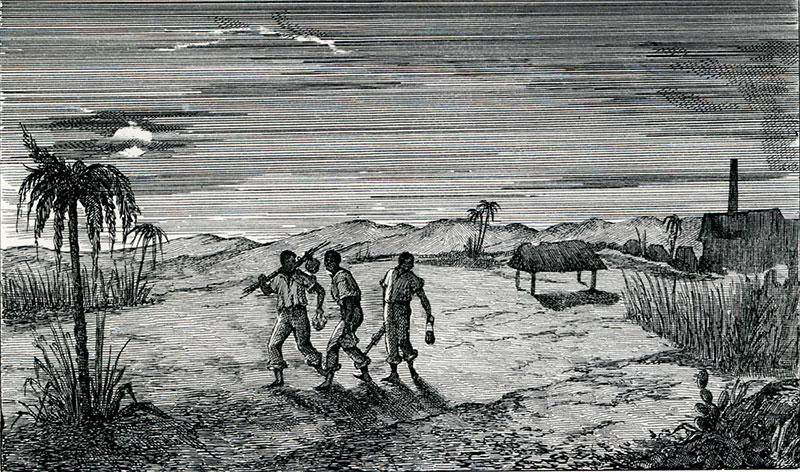
For a long time, it was accepted that the term ‘marron’ (fugitive or fugitive slave) originated with the experience of the Spanish in American Indian society. Victor Schoelcher referred to the term ‘cimarron’.
For Mediaevalist scholars, the word ‘cimarron’, which actually means ‘thicket’ or ‘brushwood’, is not appropriate when referring to the fugitive, the slave that has broken away. They prefer to establish a link between terms commonly used in the 14th century: ‘marron – marronniers’: mountain guides and porters in the Alps, ‘marronnier’: a pirate and ‘marroner’: being a pirate, ‘marron’ et ‘latrone’: thieves. The ‘marrons’ were the first generation of mountain settlers to have cleared the land and settle in certain Alpine localities. The word ‘marron’ can be found in the Romance language, then in French, to refer to domestic animals gone feral.
The French who settled on Bourbon island in the 17tha and 18th centuries used the term to refer to domestic animals gone astray, which explains the use of the terms ‘chat marron’ (stray cat), ‘cabri marron’ (stray goat) and ‘porc marron’ (stray pig), still used today, which they then extended to slaves who had escaped from their owner’s estate and taken shelter in the mountains. in 1997, Marcel Lachiver’s Dictionnaire du monde rural (Dictionary of rural society) defined the word ‘marron’ as follows: domestic animal returned to the wild.
La Hure (1671-1674) was one of the first authoritarian and tyrannical governors. Legend has it that he had Véron, his storekeeper, shot, then quartered. To escape from his tyranny, a few of his slaves fled and settled on the peak of Piton de Grande Anse, resulting in their being qualified as ‘kivis’, a Madagascan word meaning fugitive. In November 1674, when the Viceroy of India Jacob Blanquet de La Haye was to visit, the governor had the fugitive population recalled. Jacques Launay patrolled the coast, blowing on a conch shell, and the fugitives returned.
Under the governor d’Orgeret (1674-1678), when the Africans learned that the Madagascans had rebelled against the French in Fort-Dauphin, on 27th August 1674, they decided to massacre all the whites, with the exception of the women, the surgeon and the priest. All those arrested were hanged and the others fled into the mountains, organising nocturnal incursions to isolated houses. The main aim of Governor Vauboulon (1689-1690) was to frighten the inhabitants. For example, he had Brocus arrested for giving onions and garlic to fugitive slaves. He sentenced him to make amends by wearing a sign on his chest and another on his back, bearing the words ‘Protector of fugitive slaves’ and to be attached to the yoke in public.
Slaves would escape because they wished to find freedom, because they were prevented from expressing their affection, they could no longer stand being beaten and humiliated, they were given insufficient food or because they were unjustly accused of various crimes. First of all, however, it was fundamentally a cultural decision. On the ship bringing them to Bourbon island, the slaves captured in Africa or Madagascar were afraid of dying at sea, believing that their soul would thus be condemned to wander aimlessly. Once they arrived on the island, they had to overcome another fear, that of dying far from their ancestors. Escaping to solve the question of their ancestral tomb was seen as a necessity.
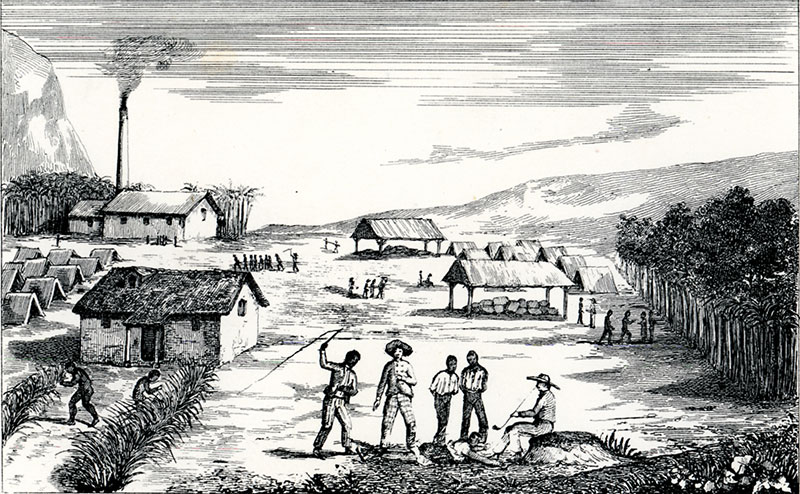
When they settled in the island’s mountains, the Madagascan fugitives set up kingdoms that imitated the political model of their country of origin. The chief was called ‘king’ and his wife was ‘queen’. The king was assisted by captains and lieutenants. When they died, the king and his military chiefs deserved a sacred tomb, the worship given to them was recognised by posterity, which explains their importance in the island’s toponymy. Thanks to these ancestral tombs, the souls of the slaves dying on the island were no longer condemned to wander. The camps and the chiefs recorded in the slave-hunters’ reports do indeed reflect the beginnings of a social organisation qualified by Jean Barassin as being a State, Kingdom or Republic. “State because it was a State in the State, without defined borders, Kingdom because there were kings and Republic because the power was in the hands of the people, devolved to those most powerful.”
The fugitive slaves gave their names to almost all the remarkable points of in the island’s mountains: Salazes, Cilaos, Cimendef, Bénoum, Orère, Anchaing, Matouta. Dimitil occupied the post of captain, reigning over a vast region stretching from the mountains above Saint-Paul to those dominating Saint-Pierre. In 1752, François Mussard, leader of a military detachment, learned of the existence of the king Laverdure and his wife, queen Sarlave. He had a lieutenant called Sarcemate. In 1844, the traveller M. C. Lavollée mentioned a cemetery situated in one of the dips in the mountain of Piton des Neiges, where the African slaves would bury the heads of their companions. In 1846, a burial chamber containing bones was found at the foot of the Salazes peaks.
The fugitives were the first to clear the land in the island’s mountains. They were self-sufficient and practised small-scale agriculture, essentially growing corn, beans, sweet potatoes and taro. They hunted wild goats, wild pigs and petrels and fished in the rivers. They also gathered honey, ‘andettes’: (larvae of insects burrowing in dead tree trunks) and fruit. Some of their huts were carefully constructed of hewn or round logs or they simply slept in a shelter also used for smoking meat and fish. Sometimes their shelters, called ‘ajoupas’, or ‘baraques’, were made of leaves or the camp was made up of ‘hangards’, another type of hut. Some simply settled in caves in groups of two or three. The camps, fortified by a fence of wooden stakes and guarded by sentinels, were located on steep ground, inaccessible and easy to watch over. Certain sites were surrounded by rocks that the fugitives would roll down the slope to delay the progress of any attackers. For weapons, to start with, they had a few guns and pistols, stolen during forays, but without gunpowder these quickly became useless. They then had to make do with assegais (spears) and the results of the struggle could only be unfavourable to them. Some, dreaming of leaving the island by sea, also manufactured dug-outs or dinghies, or even rowing boats. For those not included in a group of experienced fugitives, life was difficult.
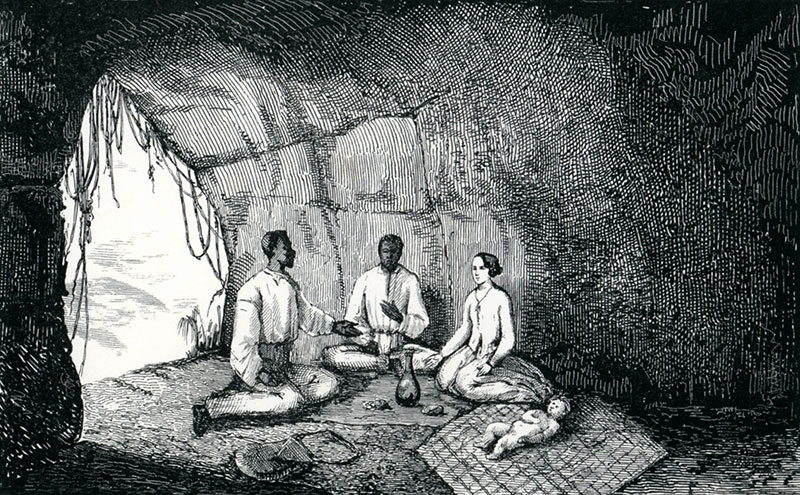
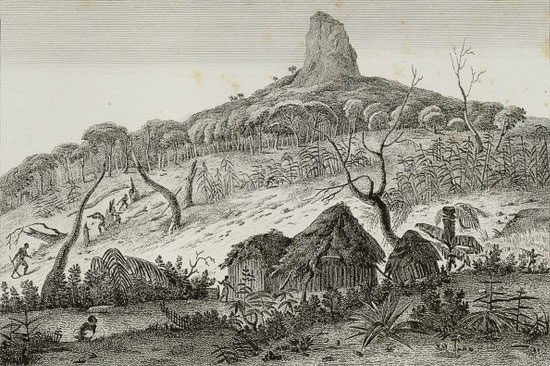
They built their camps composed of different types of hut (‘ajoupas’ or ‘hangars’). They planted and tested different herbs and medicinal plants. The women would make the clothes and the chiefs wore the distinctive clothing of their country of origin. Samson, a Sakalave chief, was ‘wrapped in a vast swathe of white cloth decorated with a bright red edge, in Madagascar called a saimbou. On his head he wore a turban, decorated with a bunch of red and white feathers.’ The ordinary fugitive would be dressed in worn-out clothes taken during forays onto the coastal estates. The women would manufacture warm clothes from bird feathers, worn by all the fugitives. They would take on a new identity and drink from the cup of their ancestral culture. In February 1801, a captured fugitive told of fifteen or sixteen fugitives living in the mountains above Saint-Denis. The chiefs of the camp, Bastien, André and Marie-Louise, belonging to Ozoux, Valentin and Ferrière, called themselves ‘Jacob’ (the name of the governor), ‘Saint-Perne’ (administrator) and ‘Madame Jacob’. They enjoyed their freedom. According to an oral tradition, reported by J-M Mac Auliffe, the locality of îlet à Cordes was lost to the fugitives during a wedding celebration. Following information given by a Madagascan fugitive called Fanor, a detachment of 35 men gave the assault. Taken by surprise, the fugitives were captured and garrotted, without offering the least resistance. The fugitives would also create sculptures.
If not included in a group of experienced fugitives, a young escapee could die of hunger, thirst, exhaustion and cold or simply fall into a precipice. He would die alone, without a tomb. Fugitives whose health was poor or who were weak had little chance of survival.
On 20th December 1747, Marie Louise and Vao fled from their master’s estate. Three days later, Vao fell sick. She died the following day. On 23rd March 1778, a slave guarding an estate in Saint-Leu came across a slave from Saint-Paul. The next day, several slaves were told to take her to the dungeon in Saint-Paul. Along the way, she asked permission to rest, sat down and died. In 1804, twenty Madagascan slaves escaped on disembarking. They walked upstream, following the river-bed of Rivière des Galets, and settled on top of a rock, feeding on fanjan or tree-ferns. The shoots of the plant produce a tender floury pulp. Former fugitives returning to an estate were used as guides for people visiting the island. The scientist Bory de Saint-Vincent was accompanied on his expeditions to the peak of the Brûlé in Saint Paul by Philippe, a former fugitive. Slaves who decided to return to an estate after a few days of freedom would often go through an intermediary such as a priest or other person known for his or her kindness, or they might ask the governor to intercede with their master, to avoid being too severely punished.
The lack of farm tools (sickles, ploughs and picks), carpentry tools (hammers, axes, saws, adzes, planes, shoulder planes, chisels, compasses and measuring tools) to organise their lifestyle, work the land to grow crops, build houses and furniture, the lack of kitchen equipment (forks, spoons, cups and jugs) and clothes to protect themselves from the cold, inevitably led them to move down to the coast. As they were not welcome, they could not obtain tools, cooking utensils or weapons without making use of tricks and violence. Such forays were greatly feared by settlers. The most extensive attacks by fugitives took place between the 1730s and the 1750s.
Chronology (non exhaustive) of forays by fugitives from 1735 to 1775
| Year | Number | place |
| 1735 | 3 | 2 in Saint-Paul 1 in Saint-Pierre |
| 1737 | 1 | Saint-Leu |
| 1738 | 4 | 3 in Saint-Paul 1 in Saint-Pierre |
| 1742 | 1 | Saint-Benoît |
| 1743 | 3 | 1 in Bras-Panon 1 in Saint-Denis 1 in Saint-Paul |
| 1747 | 1 | Grande-Chaloupe |
| 1750 | 2 | 1 in the mountains above Sainte-Marie 1 in the mountains above Saint-Paul |
| 1752 | 1 | Sainte-Marie |
| 1758 | 1 | Rivière-des-Pluies |
| 1759 | 1 | Rivière-des-Pluies |
| 1764 | 1 | Saint-Denis |
| 1765 | 1 | Saint-Paul |
| 1766 | 1 | Saint-Paul |
| 1775 | 1 | Grande Ravine |
The chiefs were the ones who outdid the others during these forays. From 1744, over a period of ten years, François Mussard organised important expeditions in the cirque of Cilaos, a focal point of fugitive settlement during that period. In 1751, he killed Mafac and his wife Rahariane. Mafac or Mafate had a historical importance (from the Madagascan mahafaka: which heals, not only using plants, but also Ran Mafaque: sulphurous water). This is not just the fruit of story-tellers’ imaginations. The space of Reunion island was domesticated and made sacred by the ombiasy (traditional Malagasy healers). The distribution of toponyms in the cirque is linked to Madagascan political tradition. The Madagascan astrological chart was superimposed onto the area of the cirque. The north (from Cap Noir to Cimendef) and east (from Cimendef to Marla) were areas attracting good omens, while the south (as far as Trois Roches) and the west (up to the most southerly point, following the crest of the Maido) attracted bad omens. The four extremities: the north east or Alahamady is the position of supreme power, the most powerful point (Cimendef), the south-east point or Asorotany is the position of sacred power, the site of the ancestors with the tombs and funeral monuments (les Trois Salazes), while the south-west or Adimisana is the negative point of the sorcerers and the north west or Adijady, the position of the profane. According to oral tradition, François Mussard did not eliminate fugitive settlements in Cilaos (the name comes from the Malagasy tsi ilaoza (na) : the place you do not leave).
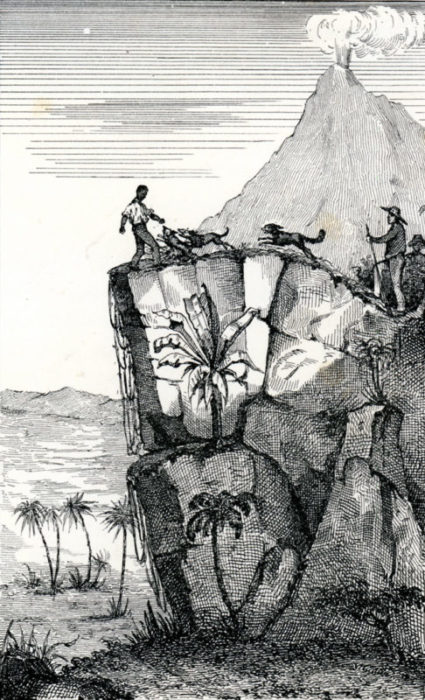
The final important struggle against fugitives apparently took place around 1829 at îlette à Malheur, above the the place named rampe Ferrand, where forty or so fugitives had settled. To reach the spot, it was necessary to climb a near vertical rock face and walk along a tree trunk placed over a precipice. The ensuing battle was a violent one. The detachment, led by Léonard Guichard, lost two men. Twenty-five fugitive slaves were killed. All the others, some injured, were taken prisoner. In 1849, the victims’ tombs could still be seen.
The expression ‘hundred years’ war’, used by Victor Mac-Auliffe to describe this manhunt, is not an appropriate one. Although the spirit of both the inhabitants and the fugitives was one of war, the struggle did not take on the form of a war. The fugitives did not act after defining a strategy or tactics, in the face of the whites in pitched battle, with as many weapons. The fugitives were victims of surprise attacks, during which they were eliminated or neutralised, without regular combat and without being able to retaliate. The combat was not an equal one. The whites were armed with guns, whereas the slaves mostly had only assegais (spears).

Nor was it a civil war reflecting a defect of the State, a weak State. In actual fact, on Bourbon island, the fight against fugitives was decided by the governor, who used forced to re-establish order. The hunters were under the orders of a strong State. In a civil war, no distinction is made between combatants and non-combatants. In the hunt for fugitive salves, the difference was quite clear. In addition, on both sides, not all the members acted with the aim of achieving victory. Attacks by fugitives were limited in space and time. It can be considered to have been a sort of guerrilla warfare before its time, since the enemy felt constantly threatened, its morale was low due to constant harassment and the combatants were virtually invisible. As the guerrillas could not win, over time, the objective was to build up a battalion sufficiently powerful to carry out wide-scale decisive operations. The forays carried out by the fugitives did not present this characteristic.
Statistical data confirm the fact that, as relayed by oral tradition, after 1748, forays were few and far between. The older Madagascan fugitives had grown wiser and no longer saw the point of carrying out forays. It was now the Africans who supported these operations. Attacks by fugitives were often the result of excessive actions of hunters, who would meticulously search the whole camp and remove everything. They would also kill the dogs that gave the warning signals. In June 1753, the men from the detachment of Patrice Droman killed 31 dogs during an attack on the camp at Bras de la Plaine. By limiting their attacks to the estates and not attacking the symbols of the decision-making power, the fugitives did not give themselves the means to crush the enemy. In addition, as they could no longer count on the support of the slaves on the estates, the prospect of forays, though the object of real terror for the masters, did not weaken the system.
The governor Mahé de La Bourdonnais (1735-1746) first organised ‘lightening raids’, the tactic being to carry out large-scale searches, but with disappointing results. On 20th March 1739, nine detachments, including one from Rivière des Remparts, two from Rivière d’Abord, one from Sainte-Suzanne, three from Saint-Paul and two from Saint-Denis, were brought together to carry out a search at la Plaine des Cafres, around the peak of Piton de Villers. Alerted by the dogs, the fugitives escaped and the hunters found 36 empty ajoupas (huts). They then decided to carry out small-scale operations, using groups of ten or so men, all sharp shooters, under the authority of an experienced captain.
Slave hunting necessitated excellent physical conditions, in order to deal with the obstacles encountered, as well as shooting skills. According to Eugène Dayot, such operations could not be carried out without a minimum of training. He mentions two types of training exercise: la loterie (a shooting exercise) and la grimpe (a climbing exercise). Training for climbing consisted first of all in grimpe sèche (simple climbing), imitating hunting for petrels and involved climbing to the top of a tree wearing two crampons. The second was grimpe chargée (climbing with a load), simulating hunting for goats or for fugitives and involved climbing up and then down the same tree carrying a thirty-pound load.
A small number of slaves saw escaping by sea at night as being the best way to get as far away as possible from the slave owners and achieve freedom. In a letter dated 19th January 1775, written to his friend Bertin, the poet Parny wrote about this type of resistance: “Their homeland (Madagascar) is two hundred leagues from here, yet they imagine they can hear the cocks crowing and smell the smoke coming from their friends’ pipes. Sometimes twelve or fifteen of them will escape, stealing a dugout and putting out to sea. They nearly always lose their lives, but this is a small price to pay for those who have already lost their freedom.” Escape by sea was a cause of concern for the civil authorities and the landowners, not so much for its destabilising factor, but for the simple losses incurred by the plantation owners. The colony found itself faced with the problem in 1704. The Higher Council imposed exemplary punishments on any slaves caught implementing their plan, with the aim of discouraging other slaves from carrying out such dreadful deeds. Though such plots were fairly rare between 1750 and the eve of the revolutionary period, many such projects were prepared.
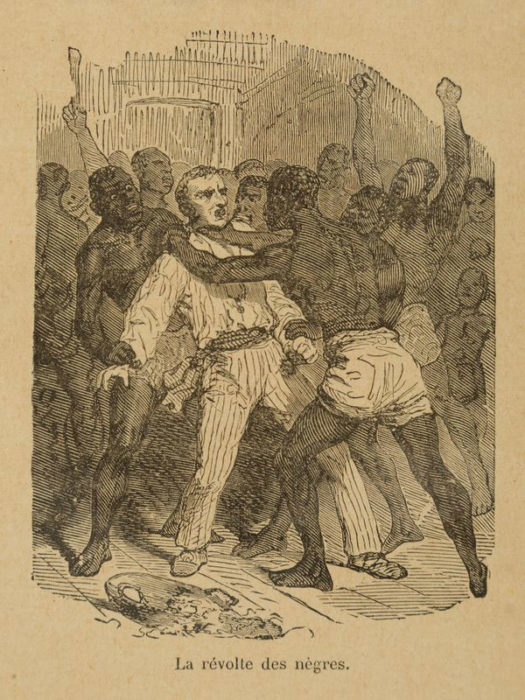
The slaves all had one desire: to be free. While some attempted to escape from Bourbon island by sea, others fled the tyranny of the plantation to take refuge in the mountains. Revolt was a far more radical form of resistance. From 1705 until the First Empire, all attempts at revolt aimed at acquiring freedom by the use of force failed, each time denounced from the inside. In 1705, in Saint-Paul, Sébastien, a slave belonging to Pierre Léger, Samban a slave of Jacques Delâtre and Mathieu, a slave of Pierre Bachelier, were sentenced to be burnt alive for having wanted to assassinate all the whites and become masters of the island. In the same district, on 1st June 1719, Louis Ponnant, a slave belonging to Antoine Cadet, was sentenced to be hanged for the crime of rebellion. Between February and May 1730, first Claude, Simayet, Cambon and François, then Barbe, Sébastien and Jacques, were tortured at the wheel before being strangled and their bodies exhibited for having wanted to kill their masters and all the whites, with no exceptions.
The administrators during the period of royalty (1767-1789) did not take seriously news of plots being hatched. Concerning the agitation of 1769, Bellecombe, the representative of king Louis XV in the colony, was convinced that this was the appropriate attitude and had no difficulty admitting that the apparent revolt of 1779 “was simply a scare, that the inhabitants made it out to be far more important than it actually was,” and that the guilty slaves just wanted to steal and perhaps set fire to the odd house and chicken-coop. A slave guarding the plantation received a few knife-wounds, quite simply because he attempted to stop a sugar-cane thief. The project of the denounced plot was, in his opinion, pitiful, since the alleged chiefs were only armed with the broken end of a bayonet and a few spears . Nevertheless, the ensuing repression was extremely severe . It had the intended effect, as for the last ten years of the Ancien régime, no other slave revolt was recorded. The only troubling event broke out in Saint-Louis in October 1788: a hundred or so slaves escaped into the mountains above the plantation owned by Grimaud . Ten years later, acts carried out by those seen to be inside enemies were often greatly exaggerated. In October 1799, in Saint Rose, according to information given to Levillan-Desrabines by Adonis, one of his Madagascan slaves, close to five hundred slaves were planning to go to Saint-Denis to put to sleep or drive crazy all the white people present at the theatre, using some kind of root.
Under the Empire, fears of an attack by the British led the inhabitants to take great precautions concerning their safety. To render them powerless and avoid hostility following the oath of allegiance, the British decided to disarm the population. Consequently, the settlers had no protection in the event of threats represented by the slaves, fearing not so much attacks by fugitives, but rather those on the plantations.
Since the 1789 revolution had not succeeded in abolishing slavery, when the island was conquered by the British in 1810, the slaves, seeing the whites disarmed, thought that the new governors would turn out to be more generous than the French. When they realised that abolition was not on the cards, in November 1811, the slaves in le Gol and Saint-Leu revolted. For the first time, a project was implemented. To defend themselves, the settlers did not wait for the British forces to arrive. They organised the retaliation themselves and took control. 135 insurgents were arrested and imprisoned in Saint-Denis. Justice being applied in the name of the king of England George III, the British magistrates condemned to death twenty-five of them. In 1832, another plot denounced in Saint-Benoît, led by a slave born in Mauritius, caused concern for the governors. The plot was not implemented. On 7th November 1836, Guillaume and Augustin were granted their freedom and an annual pension of 360 francs for having denounced the last plot prepared in Saint-André.
This type of resistance concerned a certain number of women slaves. Unable to break the chains of slavery, they did want to bear the responsibility of bringing into the world a human being who would also become a slave. Married women slaves would delay conceiving and thus limit the number of children borne. During the period of royalty, Bellecombe and Crémont attempted to encourage slave women to bear children by giving them incentives. The proposal to grant freedom to slave couples giving their master ten children showed their desire to attempt to counter the slaves’ resistance: the project failed. The author of a dissertation about Bourbon island in 1785 explains the failure of the natalist policy: “The main reason was that most of the women would destroy the fruits of their union, not wishing to bring into the world children who would be as miserable as them.” Under the restoration, the situation did not improve when the French State decided to abolish the slave-trade in 1817, otherwise the landowners would not have needed to bring in slaves secretly, before calling on workers under contract. The recomposed families that were formed when slavery was abolished must not lead us to see giving birth to children by women slaves as a supreme act of resistance.
Singing, dancing, inventing riddles (sirandanes) and jokes were strategies applied by the slaves with the aim of protecting themselves against the darkness of slavery and avoid being crushed by the stress of the economic system in application. Thanks to these activities, they felt free and could avoid thinking about the society they lived in.